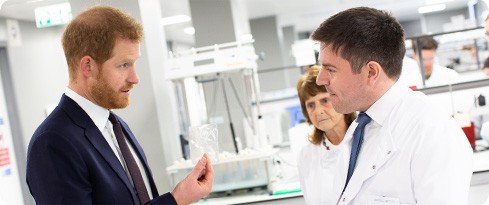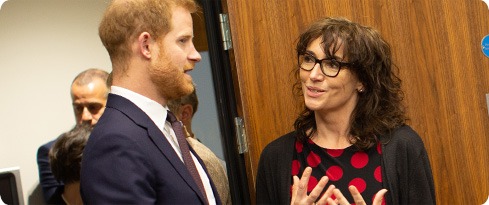Your views

Your feedback is vital to us as we continue to increase the quality of our services.
You are here:
Date: 19 November 2024
Time: 23:11

HRH The Duke of Sussex visits QEHB site
Story posted/last updated: 07 March 2019
His Royal Highness (HRH) The Duke of Sussex met scientists and clinical experts from the University of Birmingham (UoB) and University Hospitals Birmingham NHS Foundation Trust (UHB) during a recent visit to the world’s first specialist military and civilian wound research centre.
HRH visited the Scar Free Foundation Centre for Conflict Wound Research, a ground-breaking national facility based at Queen Elizabeth Hospital Birmingham (QEHB), which aims to minimise the psychological and physical impact of scarring and limb loss among Armed Forces personnel injured in service and civilians wounded in terrorist attacks.
The Duke met with the UoB team behind one of the centre’s flagship research projects, which is developing new treatments to reduce scarring. The treatments, being developed by scientists at the University’s Institute of Inflammation and Ageing and College of Engineering and Physical Sciences, include a laser therapy to correct historic scars and a pro-healing protein called Decorin being developed within a new biomaterial gel for use as an anti-scarring dressing.
HRH observed veterans, seriously injured while serving in Iraq and Afghanistan, taking part in a workshop that is part of the centre’s project piloting tailored psychosocial treatments to help them cope with life with an altered and scarred appearance.
Those taking part in the study have been recruited through The CASEVAC Club, which represents injured veterans, and the research is being carried out in partnership with the Centre for Appearance Research at the University of the West of England.

Dr David Rosser, UHB Chief Executive, said: “The Trust has a long and proud history of collaboration between both military and NHS clinicians and patients. This combined experience of treating both civilian trauma patients and injured personnel has led to the development of pioneering surgical techniques in the management of ballistic, blast and burns trauma, including bespoke surgical solutions for previously unseen injuries.
“To further this work through research will leave a lasting legacy in the improved rehabilitation of our most seriously injured patients.”
Professor Sir David Eastwood, Vice-Chancellor at the UoB, was among those to welcome HRH to the centre on Monday 5 March 2019. He said: “We have a long and proud history of collaborating with partners to support life changing research and our work with the Scar Free Foundation and UHB sees us combine our expertise with the goal of achieving scar free healing within a generation. I was delighted to welcome HRH The Duke of Sussex today to see our crucial work in this area first hand.”
Brendan Eley, Chief Executive of the Scar Free Foundation, said: “Scarring not only has a lasting physical effect, but can have a serious emotional impact long after the wounds themselves have healed.
“The visible changes in appearance caused by conflict injuries that result in looking ‘different’ can be distressing for military personnel and their families.
“With the help of the people who have experienced this kind of life changing injury we can learn what support is needed by those affected, and develop tailored interventions for the armed forces community, an important part of our goal to deliver scar free healing within a generation.”
The Scar Free Centre for Conflict Wound Research was officially opened by the Scar Free Foundation’s patron, the Countess of Wessex, in November 2018. It has been established in partnership with the UoB, UHB, the Centre for Appearance Research at the University of the West of England, and The CASEVAC injured veterans club. The centre is closely integrated with a wider network of academic and clinical institutions in the UK and beyond to ensure that the work is inclusive and at the forefront of scarring research.
Photography by James Allan.

Getting here
Information about travelling to, staying at and getting around the hospital.

Jobs at UHB
A great place to work. Learn why.
news@UHB


RSS feed
Subscribe to our news feed


